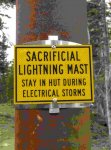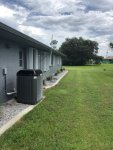- Joined
- Jun 13, 2018
- Messages
- 869
I like this photo -

I spent a hairy evening in this hut (its actually a cabin perched near the summit of a 13,000+ foot mountain) during what could only be called something out of Modest Mussorgsky's ** "Night on Bald Mountain."
We mostly perched on stools, the legs of which were mounted on large glass telephone-pole insulators; we perched in the centre of the main room away from the windows as lightning flashed all about the mountain .
One hit after another struck that mast, all evening long. With each strike it rang out like a bell, while St. Elmo's Fire crackled and danced along the edges of the window sills.
Even after the storm passed, no one could relax.... and sleep that night was fit-ful at best.
Lauri
____________________________________________________________________
**

I spent a hairy evening in this hut (its actually a cabin perched near the summit of a 13,000+ foot mountain) during what could only be called something out of Modest Mussorgsky's ** "Night on Bald Mountain."
We mostly perched on stools, the legs of which were mounted on large glass telephone-pole insulators; we perched in the centre of the main room away from the windows as lightning flashed all about the mountain .
One hit after another struck that mast, all evening long. With each strike it rang out like a bell, while St. Elmo's Fire crackled and danced along the edges of the window sills.
Even after the storm passed, no one could relax.... and sleep that night was fit-ful at best.
Lauri
____________________________________________________________________
**
Last edited:





